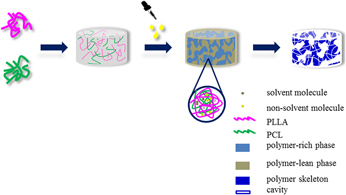Article contents
A green and facile strategy for hierarchically porous poly(L-lactic acid)/poly(ε-caprolactone) monolithic composites
Published online by Cambridge University Press: 16 July 2019
Abstract

Hierarchically porous poly(L-lactic acid) (PLLA)/poly(ε-caprolactone) (PCL) monolithic composites were fabricated by nonsolvent-induced phase separation (NIPS) method without any template for the first time. A homogeneous hierarchical porous structure with relatively large specific surface area containing both mesopores and macropores was confirmed by pore size distribution plots and scanning electron microscopy images, respectively. Fourier transform infrared analysis (FTIR) revealed that PLLA and PCL were physically blended. Differential scanning calorimeter (DSC) analysis further showed that the two components were physically blended but had a slight thermal compatibility. Meanwhile, X-ray diffraction (XRD) tests indicated that the addition of PCL hindered the crystallization of PLLA. Herein, the formation of the mesopores and macropores during the phase separation process was explained from the microscopic point of view according to the results of XRD and DSC. The present monolithic composites with hierarchically porous structures had promising prospect for applications of tissue engineering.
Keywords
- Type
- Article
- Information
- Journal of Materials Research , Volume 34 , Issue 17: Focus Issue: Building Advanced Materials via Particle Aggregation and Molecular Self-Assembly , 16 September 2019 , pp. 2990 - 2999
- Copyright
- Copyright © Materials Research Society 2019
References
- 8
- Cited by




